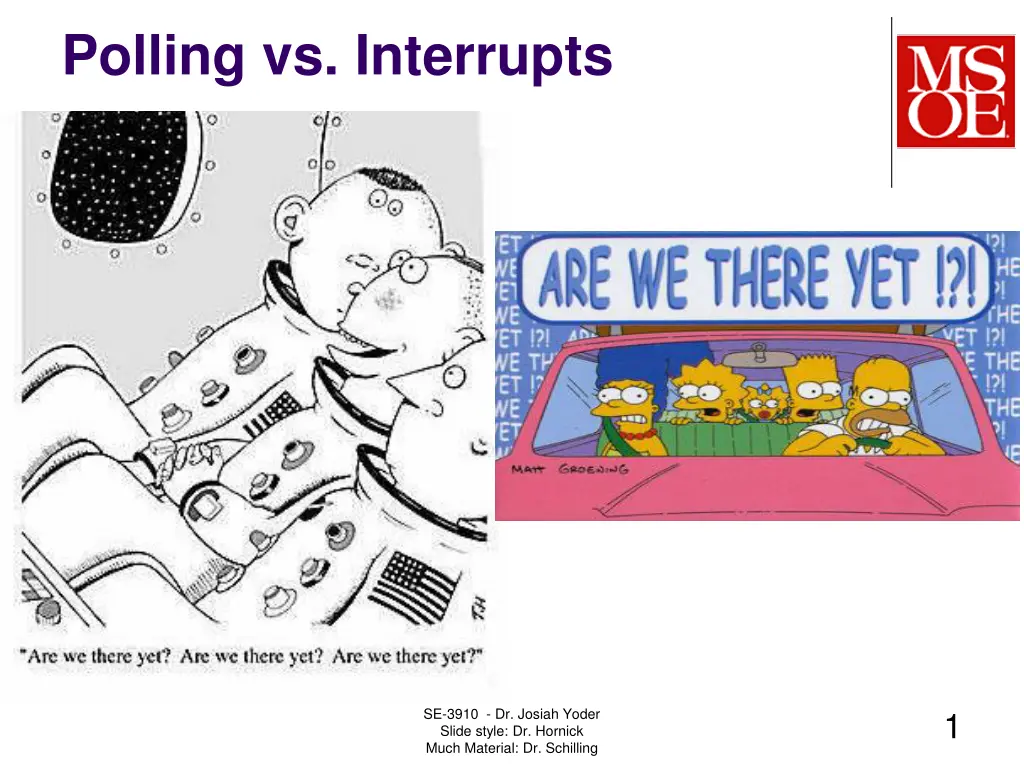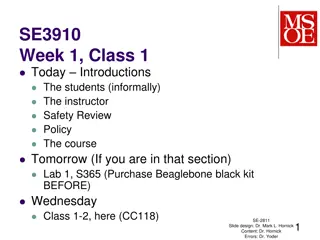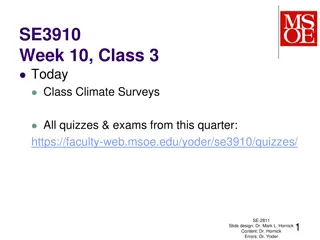
Understanding Real-Time Systems and Embedded Technology
Explore the concepts of real-time systems and embedded technology through topics such as polling vs. interrupts, response time, latency, and system design. Discover the importance of rapid responsiveness in user-controlled processes and hardware-software combinations to perform specific functions.
Download Presentation

Please find below an Image/Link to download the presentation.
The content on the website is provided AS IS for your information and personal use only. It may not be sold, licensed, or shared on other websites without obtaining consent from the author. If you encounter any issues during the download, it is possible that the publisher has removed the file from their server.
You are allowed to download the files provided on this website for personal or commercial use, subject to the condition that they are used lawfully. All files are the property of their respective owners.
The content on the website is provided AS IS for your information and personal use only. It may not be sold, licensed, or shared on other websites without obtaining consent from the author.
E N D
Presentation Transcript
Polling vs. Interrupts SE-3910 - Dr. Josiah Yoder Slide style: Dr. Hornick Much Material: Dr. Schilling 1
SE3910 Week 2, Class 1 Today Real-Time Systems Week 3 Lab Quiz 2 More circuits? Real-time systems Latency ? Lab 3 Measuring Latency Complete prelab before lab GB downloads, etc. SE-2811 Slide design: Dr. Mark L. Hornick Content: Dr. Hornick Errors: Dr. Yoder
What would you most like to do? Please take this survey: (You only need to pick 5) http://pollmill.com/f/what-would-you-most-like- to-do-m6e93hx.fullpage OR http://bit.ly/1F9RxRo And then . http://pollmill.com/private/forms/what-would- you-most-like-to-do-m6e93hx/answers SE-2811 Dr.Yoder 3
Real-time and Embedded Real-Time responding as rapidly as required by the user or the process being controlled. - Random House Dictionary (Abbrev.) Embedded System A combination of hardware & software to perform a specific function -Dr. Schilling s slides Often real-time SE-1021 Dr. Josiah Yoder Slide style: Dr. Hornick 4
SE-1021 Dr. Josiah Yoder Slide style: Dr. Hornick Slide copied from Dr. Schilling s Slides 5
What is a system? System A mapping from a set of inputs to outputs SE-3910 - Dr. Josiah Yoder Slide style: Dr. Hornick Much Material: Dr. Schilling 6
Example: Weather Monitor SE-3910 - Dr. Josiah Yoder Slide style: Dr. Hornick Much Material: Dr. Schilling 7
Response Time & Latency Response Time The time between input events and all possible output events Release Time When a process is ready to start SE-3910 - Dr. Josiah Yoder Slide style: Dr. Hornick Much Material: Dr. Schilling 8
Response Time & Latency Latency - a time delay between stimulus and response, or between cause and effect (Wiki) Memory Latency Delay between write & read (Wiki) Interrupt Latency Delay between stimulus and starting handler Audio Latency Delay from audio in to audio out of a system (=response time) Network Latency Delay from send to receive [or ] Conclusion: Latency = response time, possibly for a sub-system SE-2811 Dr.Yoder 9
Real-Time System Terminology Soft No system failure on failure to meet response time requirement (deadline) Firm System failure on failure to meet multiple deadlines Hard System failure on failure to meet a single deadline SE-3910 - Dr. Josiah Yoder Slide style: Dr. Hornick Much Material: Dr. Schilling 10
Exercise On your own: Write which kind of real-time system is being used With your partner, discuss & fill in the explanations System Video Surveillance System for Car Dealership Laser welding robot to construct car frames Classification Explanation 2 player air hockey game on game console 11
Five Misconceptions (paraphrased from Laplante and Ovaske) Real-time systems are fast All you need is a real-time OS a rate-monotonic scheduler lots of scheduling theory We ve figured out how to make real-time systems SE-3910 - Dr. Josiah Yoder Slide style: Dr. Hornick Much Material: Dr. Schilling 12
Microcontroller vs. Microprocessor Microprocessor a single chip holding a single (large) CPU what most PC s have Microcontroller A single chip holding a CPU, memory, peripherals What s on the Beaglebone Black SE-2811 Dr.Yoder 13
System on a Chip vs. MicroController Microntroller see previous System on a Chip broader will include microcontroller may include more, for example analog components CE1901/CE1911 students use a SoC consisting of a microprocessor and an FPGA SE-2811 Dr.Yoder 14
The AM 335x (The Beaglebone s CPU chip) SE-2811 Dr.Yoder 15 http://www.ti.com/lit/ds/symlink/am3358.pdf
An i5 (Intel chip in laptop) http://aphnetworks.com/reviews/intel_core_i5_7 50/2 Dr.Yoder SE-2811 16
Timing Terminology Event A jump in the program counter Synchronous Predictable. Scheduled. In sync with other events Asynchronous Unpredictable. Unscheduled. External requests Aperiodic No fixed period, asynchronous Sporadic Extremely infrequent and aperiodic Punctual Neither early nor late SE-3910 - Dr. Josiah Yoder Slide style: Dr. Hornick Much Material: Dr. Schilling 17
What is an event? for example, in SE 1021 SE-2811 Dr.Yoder 18
I/O hardware External pin Inside the device Laplante and Ovaske 4E, p. 52 SE-2811 Dr.Yoder 19
Interrupt Definitions Interrupt An event in hardware that triggers the processor to jump from its current program counter to a specific point in the code. Interrupt Service Routine (ISR) The function that is called or the particular assembly code that is executed when the interrupt happens is called the Interrupt Service Routine (ISR). Interrupt flag (IFG) this is the bit that is set that triggers the interrupt, leaving the interrupt resets this flag to the normal state. Interrupt Enable Control bit that tells the processor that a particular interrupt should or should not be ignored. Interrupt Vector Table A table in memory which maps ISRs to interrupts. 20
ISR Handling (1) [Discussed at high level Interrupt like any other event, only triggered by hardware] SE-3910 - Dr. Josiah Yoder Slide style: Dr. Hornick Much Material: Dr. Schilling 21
ISR Handling (2) Fig 2.14 p. 54 Laplante and Ovaske 4E PIU Peripheral interface unit 22



